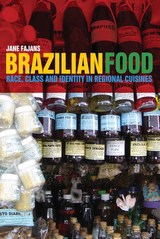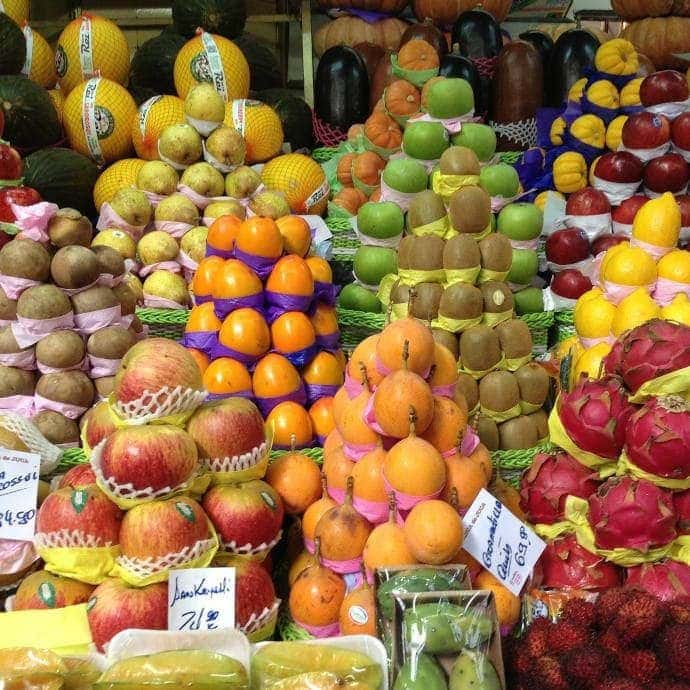“The symbolic power of foods…is different from (even if related in some manner to) the tactical and structural power that sets the outermost terms for the creation of meaning. The power resting within outside meaning sets terms for the creation of inside, or symbolic, meaning…what is needed is a concerted effort to study the various ways in which stable food habits can be called into question.” – Sidney W. Mintz, Tasting Food, Tasting Freedom: Excursions into Eating, Culture, and the Past (22-3)

Fajans also addresses the everydayness of food, exploring what is naturally kept hidden—borders, ethnic identities, class positions, racialisation, ideals of modernity—and what food can do to make them visible, particularly the promise and the myth of a unified nation.
In the book’s introduction, Fajans explains that she is particularly interested in identity and regionalism because of a growing feeling of a singular national belonging in Brazil, where the nation’s elites control “sites of unity”, including soap operas, Carnival, sporting events, and ecotourism. For Fajans, thinking with food helps us reconsider the ways that region has been understood as both a fixed site for understanding the particularities of people and “their” food, and porous, movable boundaries that can be crossed by food. By interrogating the cultural and culinary values of various regions, Fajans counters a holistic narrative of nation and nationalism, writing the nation as both a multiplicity of Brazils and a celebration of Brazil as a discursive whole.
Fajans uses the majority of her text to detail the complex differences between singularity of, or kinship among, regional Brazilian cuisines. Each chapter is rich in ingredients, techniques, and stories, and asks how food co-substantiates identity, labor, regionalism, and terrior. By crossing regions, thinking through specific ingredients (acai, dendê oil), and examining what is produced in cosmopolitan food centres (São Paulo and Rio de Janeiro), Fajans asks how food is a site of differentiation—racial, regional, classed, laboured—that also contributes to a singularising kind of identity creation. In Brazil, the historical legacy of multiple colonialisms and transnational exchanges, from the influences of Portugal to the more recent East Asian influence via chefs, both come together to create what is called Brazilian food. This multiplicity of influences and exchanges reinforce the value of and difference among regional food cultures.
For Fajans, food also makes meaning as it moves—the same dish might be made using the same basic ingredients in two regions, but the way it is consumed, classed, and the place it holds at mealtime is different. Fajans shows how the meanings of individual dishes are solidified and rendered visible when the dishes themselves are threatened. Other dishes retain and produce meaning in their everydayness and their place at every table. One of the most striking examples she uses to illustrate this is the dish feijoada, touted as the national dish of Brazil.
By centralising feijoada’s “nationalness”, Fajans show how its multiplicity of provenances and places at the table might help us consider Brazilianness as a whole.
Feijoada (a stew of beans, meats, and flavorings that is often accompanied by many side dishes, including rice, uncooked salsa, and couve, or “collard greens”) has roots in the kinds of ‘make due’ dishes that are the base of so many culinary foodways. Fajans explains that the origin story people often invoke about the dish is that it emerged from the ingenuity of slaves who made tasty dishes out of what was left in the master’s pantry. Part of feijoada’s mythic status at the tables of Brazilians is its “melting pot” quality, where it is thought to represent the nation; Fajans extends this, comparing the dish to French cassoulet, Tuscan beans cooked with meat, or feijoadas from Portugal (p. 89). More than this, however, feijoada illuminates the way that stories about the nation travel, particularly among the upper and middle classes, who narrative the equality of Brazilians of indigenous, European, and African ancestries.
Feijoada itself disrupts this discursive egalitarianism—it is not consumed by everyone at the same time every day, but rather “a whole sector of the country does not partake in the ritual except as laborers…They are not included as ‘family’ or granted commensal relations through eating together” (p. 96). Feijoada, a melting pot of a national dish, becomes for Fajans a way to highlight the still extreme classed, ethnic, and gendered distinctions between Brazilians.
In this way, it is feijoada that makes meaning from within the myths of national unity that disenfranchise many Brazilians: those who labor in the very kitchens that produce “national” food.
The book’s last chapter, The Chemistry of Identity: Cooking Up a New View of a Nation, brings all of these themes together in a discussion of restaurant cooking, cookbooks, tourism, and a discourse of rescue that many have applied to regional foods and cuisine. Many of the people Fajans encounters in this chapter think deeply about ingredients, their preparation, and the histories they carry—from the environmental chef who sits with the author and a group of anthropologists at dinner, lovingly telling them about the ingredients he used in each dish, to the cosmopolitan cook who embraces fusion cooking while adopting the ingredients and techniques of the “regional hinterlands” (p. 103). In so doing, they increase the visibility of regional cuisines. This happens both when regional cuisines are more deeply attached to their regional provenance, and when they blend and fuse with national and international cuisines, exceeding the boundaries of the region and nation through cooking, eating, and sharing food.
Brazilian Food allows us to rethink the function of nationalism in a country where diversity is visibly celebrated. By using food as her primary tool to think with, Fajans interrogates how food is connected to individuals’ racial, regional, and national identities.
Food also allows her to ask how cooking, selling, and writing about food might tell stories about identity, regionality, and nationality that disrupts each of these categories; each is a moving target, intersecting and diverging across a meal, a dish, and within eating communities. Most importantly, by thinking through the function and provenance of eponymous dishes, Brazilian Food interrogates how food might carry traces of its temporal, spatial, ethnic, and regional history. For Fajans, it is the very kinds of power that food animates that makes it so incredibly good to think with.
References
Mintz, Sidney W. 1996. Tasting Food, Tasting Freedom: Excursions into Eating, Culture, and the Past. Beacon Press.
Fajans, Jane. 2012. Brazilian Food: Race, Class and Identity in Regional Cuisines. Oxford: Berg Publishers. 160 pp. Pb: £17.99. ISBN: 9780857850423
Featured image (cropped) by Jason Rosenberg (flickr, CC BY 2.0)









